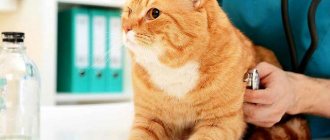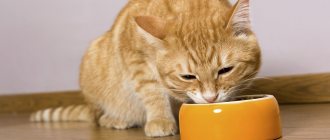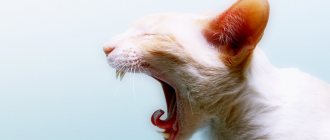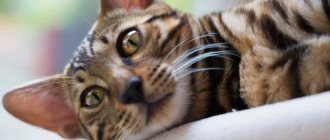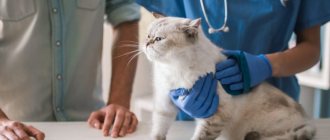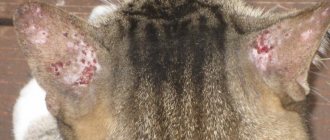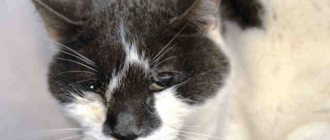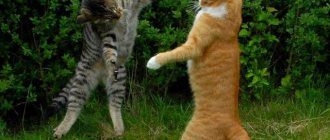Kitten diseases are an extremely dangerous phenomenon; newborn kittens are blind and deaf, their digestion and heat exchange are poorly developed. They are protected only by the warmth of the mother cat and her immunity, but after 1.5 months the kittens gradually lose this protection. In such a situation, even a mild infection can lead to the death of the kitten.
So what diseases threaten little kittens, how to treat them and how to prevent them?
Fading kitten syndrome
Causes of fading kitten syndrome: placental abruption, improper nutrition of the mother cat, errors in selecting a breeding pair, diseases suffered by the mother cat during pregnancy.
Symptoms: the kitten’s body weight is 25% less than the weight of other kittens, hypothermia, dehydration, cessation of movement.
Prevention: proper feeding of the mother cat during pregnancy; vaccinations for the mother cat on schedule.
Treatment for fading kitten syndrome: no; kittens die.
Toxic milk syndrome in kittens
Causes of toxic milk syndrome: metritis or acute septic mastitis in a mother cat.
Symptoms: kittens stop sucking milk and meow pitifully; bloating, diarrhea, anal inflammation, dehydration, blood poisoning.
Prevention: regularly check the condition of the mother cat’s nipples and milk.
Treatment of toxic milk syndrome: kittens are immediately transferred to artificial feeding; 0.5 ml of smecta 3 times a day (to treat diarrhea); contact your veterinarian immediately.
Note: if the kittens have had diarrhea for a long time, and they are still very small, then most likely the kittens will not survive.
Hypogalactia in cats (insufficient milk production)
Causes of hypogalactia in cats: insufficient nutrition of the cat's mother, illness of the mother cat, a large number of kittens in the litter, the cat's first birth.
Symptoms: Kittens are not gaining or losing weight.
Prevention: balanced and plentiful nutrition for the mother cat.
Treatment of hypogalactia in cats: improving the nutrition of the mother cat or transferring the kittens to artificial nutrition; after 3-4 weeks, complementary feeding is possible.
Anemia of newborn kittens
Causes of anemia in newborn kittens: anemia in the mother cat, intestinal parasites in the mother cat.
Symptoms: developmental delay, pale mucous membranes.
Prevention: timely treatment of the mother cat.
Treatment of anemia in newborn kittens: immediately contact a veterinarian; iron fortified food.
Hemolysis or blood incompatibility in kittens
Causes of hemolysis in kittens: different blood types in the mother cat and kittens, which causes the breakdown of red blood cells in the latter.
Prevention: carrying out tests for the blood type of kittens' parents; conducting a test for brown urine: after the first feeding with mother's milk, kittens are induced to urinate; normally, the urine is colorless; If the urine is brown, the kittens are transferred to artificial feeding.
Symptoms: refusal of milk, weakness, brown urine, yellowness, death of the tip of the tail.
Treatment of hemolysis in kittens: no; most kittens die.
Viral pneumonia in kittens
Causes of viral pneumonia in kittens: lack of vaccinations in the mother cat, weakening of passive (maternal) immunity in the period from 6 to 12 weeks of the kitten’s life, the mother cat suffered a viral disease during pregnancy.
Prevention: vaccinations for the mother cat on a schedule, preventing kittens from communicating with strangers and animals, maintaining maximum sterility in the kittens’ nest, maintaining temperature conditions.
Symptoms: kittens stop sucking and meow pitifully; lacrimation, cough, sneezing, nasal discharge, mouth ulcers, conjunctivitis, fever; Very young kittens can die suddenly.
Treatment of viral pneumonia in kittens: At the first symptoms, contact your veterinarian immediately.
Neonatal infectious peritonitis of kittens
Causes of infectious peritonitis in kittens: lack of vaccinations in the mother cat, weakening of passive immunity in the period from 6 to 12 weeks of the kitten’s life, the mother cat suffered a viral disease during pregnancy.
Symptoms: exhaustion, weakness, fading, difficulty breathing, turning blue.
Prevention: vaccinations for the mother cat on a schedule, preventing kittens from communicating with strangers and animals, maintaining maximum sterility in the kittens’ nest, maintaining temperature conditions.
Treatment of infectious peritonitis in kittens: no, death is inevitable; Immediate isolation of a sick kitten is required to prevent infection of healthy ones.
Note: the most susceptible to this disease are Abyssinians, Bengals, Burmese and Persian color-point cats, as well as Ragdolls and Rexes.
How to tell if your kitten is sick
Before talking about diseases of cats, it is worth understanding how to identify the deterioration of the animal’s condition. Let's start with how to understand that a kitten is sick. We will talk about deviations from the norm.
To notice abnormalities, you must spend a lot of time with your pet.
You must know his behavior, habits, needs and characteristics that are specific to this particular kitten.
For example, your kitten loves broccoli, which is a specialty. And if he constantly uses this product, and at a certain moment refuses it, then this can be considered a deviation from the norm.
Of course, if your pet refuses certain food, this is not a 100% sign of the presence of a disease, but pay attention to the following abnormalities that appear in sick animals:
- The kitten stops being active. He is no longer interested in playing with you or any toys. The animal loses interest in the world around it, which is unusual for small cats.
- The animal sleeps constantly. Of course, cats spend much more time sleeping than people, but there is a limit to everything. If an animal sleeps all day, then something is definitely wrong with it.
- Lack of appetite. In order for the body to grow and develop, it needs a lot of energy, so kittens consume large amounts of food. If a pet refuses to eat, it means that he has problems that need to be solved, otherwise growth will stop and body weight will begin to decrease.
- Hair loss or scratching of certain areas of the body. A healthy kitten will never scratch its skin until it bleeds if there are no parasites or skin diseases on it. The coat does not renew itself often, so repeated hair loss indicates a problem.
- Noticeable discharge from the eyes, nose, mouth. Any discharge that has not previously been noticed indicates illness. Remember that we have a runny nose for a reason, but is a symptom of a cold or flu. In cats, such discharge may also indicate a disease.
Important! Temperature above 39
°
C, as well as a pulse of more than 200 or less than 100 beats per minute indicate health problems.
This list can be expanded further, but it is better to summarize all of the above. If an animal’s behavior, habits, or attitude towards others changes, then it has a problem.
A kitten cannot suddenly become different, just like a person, so you should not turn a blind eye to such changes.
Conjunctivitis of newborn kittens (ophthalmia neonatorum)
Causes of conjunctivitis in newborn kittens: the mother cat suffered a viral disease during pregnancy; scratches or other damage to unopened eyes.
Prevention: vaccinations for the mother cat on a schedule, preventing kittens from communicating with strangers and animals, maintaining maximum sterility in the kittens’ nest, maintaining temperature conditions.
Symptoms: pus is released from under closed eyelids, crusts appear, the eyelids are red and swollen.
Treatment of conjunctivitis in newborn kittens: open eyelids, rinse eyes with 2% boric acid solution 4 times a day, antibiotic eye drops 4 times a day after rinsing. It's better to consult a veterinarian.
The danger of pet pathologies for the owner. Can a sick kitten infect a child?
Every owner of a little friend needs to know whether his kitten’s pathology is dangerous for himself. Of all the things that kittens get sick with, only parasites can seriously harm a person.
For example, it is easy for the owner of a kitten to become infected with worms, which will take root well in his body at normal body temperature, comfortable for their development. Most veterinarians recommend that pet owners give their kittens dewormers as a preventative measure.
Fleas can also get on the human body, but they do not stay there for long. However, the possibility of infection cannot be ruled out. It is also possible for parasites to get into the kitten’s owner’s sleeping area. The main danger of fleas is not that they cause discomfort, but that they are carriers of a large number of diseases.
One of the dangerous diseases for humans that kittens can suffer from is lichen, which causes destruction of the nail plates and hair. The most detrimental consequence can be damage to the bone tissue, and as a result, the brain.
Inflammation of the navel in kittens
Causes of navel inflammation in kittens: too short umbilical cord stump, too long umbilical cord stump, unsanitary conditions in the kittens' nest, disease of the mother cat's teeth and oral cavity.
Symptoms: the navel is red and swollen, pus is discharged.
Prevention: proper cutting of the umbilical cord, treating the umbilical cord stump with an antiseptic, checking the health of the mother cat, preventing kittens from communicating with strangers and animals, maintaining maximum sterility in the kittens’ nest.
Treatment of navel inflammation in kittens: contact your veterinarian immediately!
Types of diseases
The unprotected and fragile organism of pets is susceptible to a huge number of diseases, and some of them are transmitted to the cubs from the mother - in her womb or during feeding with milk.
What diseases do small kittens have?
- Fading kitten syndrome.
- Toxic milk syndrome.
- Hypogalactia.
- Anemia in newborn domestic animals.
- Hemolysis.
- Viral pneumonia.
- Neonatal infectious peritonitis.
- Conjunctivitis.
- Inflammation of the navel.
- Dehydration.
- Hypothermia.
They are also susceptible to pathologies that are typical for adults: helminthiases, distemper, rabies, and the baby is not protected from the effects of fleas and ticks.
Dehydration (dehydration of the kitten)
Causes of kitten dehydration: The kitten is too small and weak from birth and cannot reach the mother cat's nipple.
Symptoms: dry mouth, the mouth and tongue are bright red, decreased muscle tone, weakness; If you pinch a kitten, the fold on the skin will remain and not straighten out.
Prevention: a weak kitten should be fed artificially or specially applied to the mother's nipple.
Treatment for kitten dehydration: Contact your veterinarian immediately!
Hypothermia
From the name it is already clear what the cause of the pathology is. In the absence of a cat and the babies being warmed with their warmth, they lose their body temperature, which drops to 35.6C. This is very little. The cubs freeze and stop moving. The same consequences will occur at low temperatures in the room where the children are.
To bring a cat baby back to life, you need to warm it up gradually, covering it in layers. Pour glucose (5-10%) into the mouth. Be sure to seek help from a doctor. To prevent such situations from happening again, pay careful attention to insulating the cat’s nest.
Hemolysis
Hemolysis is the death of kittens due to blood incompatibility. Not long ago, another explanation was received for the possible cause of death of newborn kittens. This problem is directly related to a topic that is still unfamiliar to our breeders - blood genetics. Blood groups are essentially antigen proteins located on the surface of red blood cells (erythrocytes).
Unlike most species of warm-blooded animals, antibodies that bind foreign red blood cells are already present in the kitten’s blood at the time of birth. Although the patterns of inheritance of cat blood groups have not yet been sufficiently studied, it is known that the genes that carry this information are located nearby, on a certain chromosome. Cats are known to have three types of blood - A, B, AB. Unlike humans, they have not been found to have a zero blood group.
Allele a is dominant over allele b. That is, a cat with blood type B is homozygous for the B allele. A cat with blood group A can be either homozygous or heterozygous for the a allele. Group AB is the rarest and least studied, but it is known that an animal with this blood type does not necessarily have parents with both blood types A and B. The most common blood type in cats is blood type A, which is dominant over B. Therefore, the consequence of this dominance is offspring who have type A blood, but often also become a “carrier” of type B blood.
Antibodies of different blood groups are not equally active towards each other. Antibodies of blood group B actively bind red blood cells present in the blood of a cat with group A. In this regard, the result of blood of group A entering the blood of a cat with group B can be the death of the animal.
Antibodies of blood groups A and AB are practically harmless to the red blood cells of blood group B. Research by scientists has proven that certain blood groups are associated with the breed and habitat of cats. Most outbred cats have type A blood. 100% of cats of eastern origin (Siamese, Orientals, Burmese, Tonkinese), Russian Blues, 95-99% of Maine Coons and Norwegian Forest cats have it.
Persian cats, Abyssinians, Burmese, Somalia, Scottish Folds, Kuril Bobtails, Sphynxes - 75-95%. Exotic, British Shorthair, Rex, with blood type A - from 50% to 70%. The remaining cats, as a rule, have blood type B. Blood type AB is found only in those breeds that can have both A and B groups.
The dependence of a cat's health on blood type has not yet been studied. But, definitely, there is some difference in animals - owners of different types of blood groups, in the peculiarities of their perception of certain diseases, different climatic conditions, or especially in the breakdown of certain products, which has already been scientifically confirmed in humans. For now, we know only about the problems received by the offspring as a result of the incompatibility of the blood groups of a cat and a female cat.
This undesirable combination, which threatens the death of the offspring, occurs when crossing a cat born from parents with different blood types (AAxBB), respectively, having blood type A, with a cat having blood type B. The kittens born as a result of this mating inherited the group from their father blood A or AB, being completely healthy at the time of their birth, are nevertheless at risk of death from hemolysis.
Antibodies contained in the mother's colostrum and having the greatest intensity, in the first 16-20 hours have a destructive effect (disintegration of red blood cells - erythrocytes) on the kittens' body. The number of red blood cells in a kitten decreases, resulting in anemia. Protein gets into the urine, the kidneys are damaged, and, as a result, the metabolism is completely disrupted.
Some of the kittens that are most sensitive to antibodies die during the first day of life, sometimes without visible signs of illness, or, refusing mother's milk, during the first three days they become very weak and also die. At the same time, they exhibit signs of yellowness and the discharge of brown urine. In some cases, kittens develop normally, without any ailments, but at the age of one or two weeks they experience a critical period, the consequence of which is the dying tip of the tail, which confirms the circulatory disorder caused by the incompatibility of blood groups.
Some kittens, having the same blood type, incompatible with the mother's, remain healthy. This happens extremely rarely and is explained either by the very low content of antibodies in the cat’s milk, or by the individual structural features of the intestinal wall, which does not allow dangerous maternal antibodies to enter the kitten’s blood. The fact that kittens during fetal development are not susceptible to the negative effects of hemolysis is explained by the fact that in cats, unlike in humans, antibodies incompatible with the fetus do not penetrate the placenta.
It should be remembered that with repeated matings of this pair, antibodies accumulate in the cat’s body. In the USA, the so-called typing of sires (determination of blood type) is common and it is proposed to exclude from breeding animals with blood group B in breeds where the number of its owners does not exceed 5% (Maine Coons and Norwegian forest cats). Our breeders, due to the lack of test kits in our veterinary services to determine the blood type of cats (if incompatibility is suspected), in order to protect newborn kittens, during the first day (first 16 hours), they feed them artificially or place them with a nursing cat with blood type A .
A few days after birth, the patency of the kitten’s intestinal walls becomes so strong that antibodies can no longer penetrate its blood. Of course, this precaution has its negative sides, since it is with colostrum that passive immunity is transmitted to kittens, protecting them from many dangerous diseases, and it is during the first feedings that globulins and the antibodies associated with them are able to be absorbed in an unchanged state. After the first few feedings this ability is lost.
If it is not possible to determine the blood type of newborns, there are other options. One of them is a urine color test. To do this, after the first, very short feeding, cotton wool should be used to stimulate the kittens to secrete urine. If someone has it brown, then there is incompatibility. Such kittens should be separated from their mother. Normally, urine should be colorless. A cat with blood type B is an ideal partner for any cat, as is a cat with blood type A. Cats with blood type A can be safely mated with cats of the same blood type.
Treatment
Treatment of viral diseases is very labor-intensive and not effective enough, because Until recently, there were no drugs in the arsenal of veterinarians (with the exception of serums) with direct antiviral activity, and treatment was actually reduced to combating the symptomatic manifestations of such infections.
Therapy for viral diseases should be aimed at restoring the protective barriers of the mucous membranes, fighting viruses, correcting the immune system (stimulating natural resistance, protecting against secondary infections), eliminating or weakening the manifestations of the disease (symptomatic therapy), as well as replacing impaired physiological functions of the body (replacement therapy). therapy).
In addition, for viral diseases, a proper diet, a balanced content of vitamins, macro- and microelements is important. This is not only an important component of therapy, but also a way to free the body from waste and toxins accumulated during illness, which is especially important after a period of anorexia or a starvation diet.
In such cases, the new drug Gamavit has proven itself most effective (contains placenta extract, sodium nucleinate, a physiologically balanced mixture of other components: 20 amino acids, 17 vitamins, nucleic acid derivatives, essential minerals and trace elements), the components of which are selected specifically taking into account the disorders that occur during various diseases.
Gamavit enhances the effect of medications, normalizes metabolic processes, neutralizes the effects of toxins, increases natural resistance, normalizes the ratio of calcium and phosphorus, and increases appetite.
At the very early stages of a viral infection, specific antiviral globulins and serums (Vitafel, Vitafel-S, etc.) are quite effective. The period of their influence on viral particles is limited (about a week from the onset of the disease) by the period of viremia.
In addition to serums, drugs of interferons and their inducers are effective in the initial stages of a viral infection: Cycloferon, discontinued for veterinary use, Camedon, Maxidin 0.4%, Neoferon, immunostimulants (Immunofan, T-activin, Mastim, Anandin), etc. are effective, in the later stages of some viral diseases their use is not recommended.
Fosprenil has proven itself to be one of the most effective drugs for the treatment of viral diseases in cats. Phosprenil is obtained by phosphorylation of polyprenols isolated from the processing of wood needles. It was developed as a result of many years of collaboration between leading scientists from the Moscow Institute of Organic Chemistry. N.D. Zelinsky, and the Institute of Epidemiology and Microbiology named after. N.F. Gamaleya.
The drug mobilizes the body's defenses, possessing powerful antiviral activity. Over more than 10 years of use, Fosprenil has saved thousands of lives of hopelessly ill cats and dogs. The combined use of Fosprenil with Maxidin and Gamavit is especially effective.
In the Russian Federation, the drug is patented as a treatment for viral enteritis, hepatitis, panleukopenia, canine distemper and other severe viral diseases. Convincing results have been achieved in the treatment, as well as, no less important, in the prevention of panleukopenia, coronavirus and other infections in cats.
Sources:
https://varlivet.ru/info/pro-virusnye-infekcii-koshek
https://www.veterinarka.ru/for-owners/virusnye-infekcii-koshek.html
https://www.vetmag.ru/advice/bolezni/iu-koshek-byvayut-orvi/
What are the main cat viruses?
Calicivirus, like human flu, has a lot of different variations and causes damage to the respiratory system. Herpesvirus - causes damage to the eyes and respiratory tract. Parvovirus is a virus that causes panleukopenia or feline distemper, which is characterized primarily by damage to the gastrointestinal tract.
Coronavirus - which causes damage to the intestines, and can also cause FIP or viral peritonitis in cats. Feline leukemia virus – causes tumors and immunodeficiency. Feline immunodeficiency virus (an analogue of HIV) causes AIDS in cats.
And of course the rabies virus. All of these viruses are most common in cats and are perhaps the most dangerous to their life and health. All of them, except the rabies virus, are safe for humans.
